
Email Countdown Timers: Boost Engagement with Litmus
Testing and performance for email countdown timers
After you’ve finished your designs, it’s time for testing.
How to test your countdown timer
Here at Litmus, we’re a little obsessed with pre-send testing, which we always recommend for any new element in your email (especially with email client support changing without warning sometimes.) You can preview your countdown timer directly in Litmus Personalize, so you don’t have to wait for a test send or toggle between multiple tools to know exactly how it appears.
Should I A/B test my countdown timer?
In addition to pre-send testing, countdown timers are a great element to A/B test in your emails. Every audience is different, and every campaign is different, so it’s the best way to find out if it really does add a sense of urgency and increase conversions or fall flat. Make sure you have a specific hypothesis behind your test – why will the countdown timer increase engagement. If there isn’t a reason for a countdown timer to be in an email, you might not see the boost in engagement that you’re looking for.
Can I track the performance of countdown timers with Litmus?
Yes! Litmus Email Analytics shows your email performance, from open to read rates . You can also use your email service provider to look at your performance.
To determine whether or not your countdown timer was successful, go back to your campaign’s goals. Is it to encourage more people to re-open the email, like our NYE Swag Drop Email, or to get more conversions, like for a Black Friday or Cyber Monday campaign? Take a look at how your countdown timers help you achieve those goals (or not!) as you evaluate it for future campaigns.
How to create an email countdown timer with Litmus Personalize
You don’t need to know how to code HTML to create a countdown timer in your email campaigns. Steps to embed your own email countdown timer in Litmus Personalize:
- Go to your Campaigns tab. There you’ll find a library of email templates you can use as a starting point. Under Templates, click Countdown Clocks > New Template.
- Upload a background image that will appear behind the day, hour, minutes, or seconds in the countdown timer.
- Add blocks to fill in the numbers, and then customize your countdown timer to the font, color, and sizing that matches your brand and email design from the editor on the right.
- If you want to create a special expiration message, scroll down on the right hand side under Expiration State and choose a custom message using the same background color to edit or upload your own image.
- Similarly, create a fallback for email clients that do not support countdown timers by going to MPP Fallback state to choose whether to hide the countdown timer entirely or create a fallback option.
- When you’re ready, click Preview and double check that it appears correctly. If it looks good, click save and name your timer.
Engage with 1:1 experiences
Deliver personalized content at scale. Use live polls, dynamic content, and advanced targeting to drive results.
Examples of countdown timers in the wild
Countdown timers are extremely versatile. It’s a common tactic to promote sales or events, but that’s just the beginning of what you can use them for:
How retailers use countdown timers
In retail, they’re predominately used to countdown until the start or end of a promotion. They’re also used a lot to visually show delivery information (e.g. two hours left to shop for next-day delivery). Brands also use them for product launches, inventory drops, or in-store events.

This timer from Kate Spade, placed directly beneath the logo, is a lovely example of a small, punchy timer that captures attention.
How financial services can use countdown timers
While financial firms have more regulations around what they can and cannot send in their emails, they can still use personalization effectively. Hard deadlines—around tax season, retirement contributions, your insurance coverage, or other application dates—can all use a countdown timer.

We created this example in Litmus Personalize to show you what it could look like.
How travel and hospitality uses countdown timers
For hotels, airlines, and restaurants, countdown timers can build a lot of excitement. It might be a countdown until your check-in time or flight, for when tickets go on sale for a special event or dinner, or to a certain local holiday.
P&O Ferries uses a roundel for their countdown timer to let customers know how long they had left to change their departure dates for no extra cost. Simple, yet effective!
How B2B companies use countdown timers
We’re big fans of the idea that B2B doesn’t have to mean boring. Embed a countdown timer to surprise customers for their loyalty anniversary, remind new customers about their free trial ending, or promote your biggest sale of the year.
This example from Wix shows how you can make the countdown timer front and center in your email, with a few supporting details on the promotion, to really make an impact.
How nonprofits and higher ed use countdown timers
They could use a countdown timer to create urgency around a donation matching time period or around application deadlines for school, a grant, or scholarships.

We created this example in Litmus Personalize to show you what it could look like.
Engage with 1:1 experiences
Deliver personalized content at scale. Use live polls, dynamic content, and advanced targeting to drive results.
Best practices for using countdown timers
Like any email marketing tactic, you don’t want to overdo it. While they can be powerful elements to add to your emails, avoid using countdown timers too frequently. Here’s how to make the most of them:
Email marketing strategy for countdown timers
If you’re doing a countdown in an email, make sure it’s tied to the rest of your promotional strategy. Will this be the last sale of the season, for example? Or the best one of the year? Ask yourself these questions as you plan your next email marketing campaign:
What types of campaigns are email countdown timers best suited for?
Use them for big events, pricing promotions, or personal things like a birthday or holiday countdown. “We only add them to an email campaign or promotion that ends,” says Carin Slater, Lifecycle Email Marketing Manager here at Litmus. “We used to put countdown timers in all of our event webinar emails, for example, but we found that because webinars are recorded, there wasn’t enough urgency there.”
Countdown timers can also be used in transactional emails (or operational emails). Below is an example from a transactional send to Litmus Live 2022 attendees featuring a countdown timer not necessarily to drive action but more so create excitement for an upcoming event.
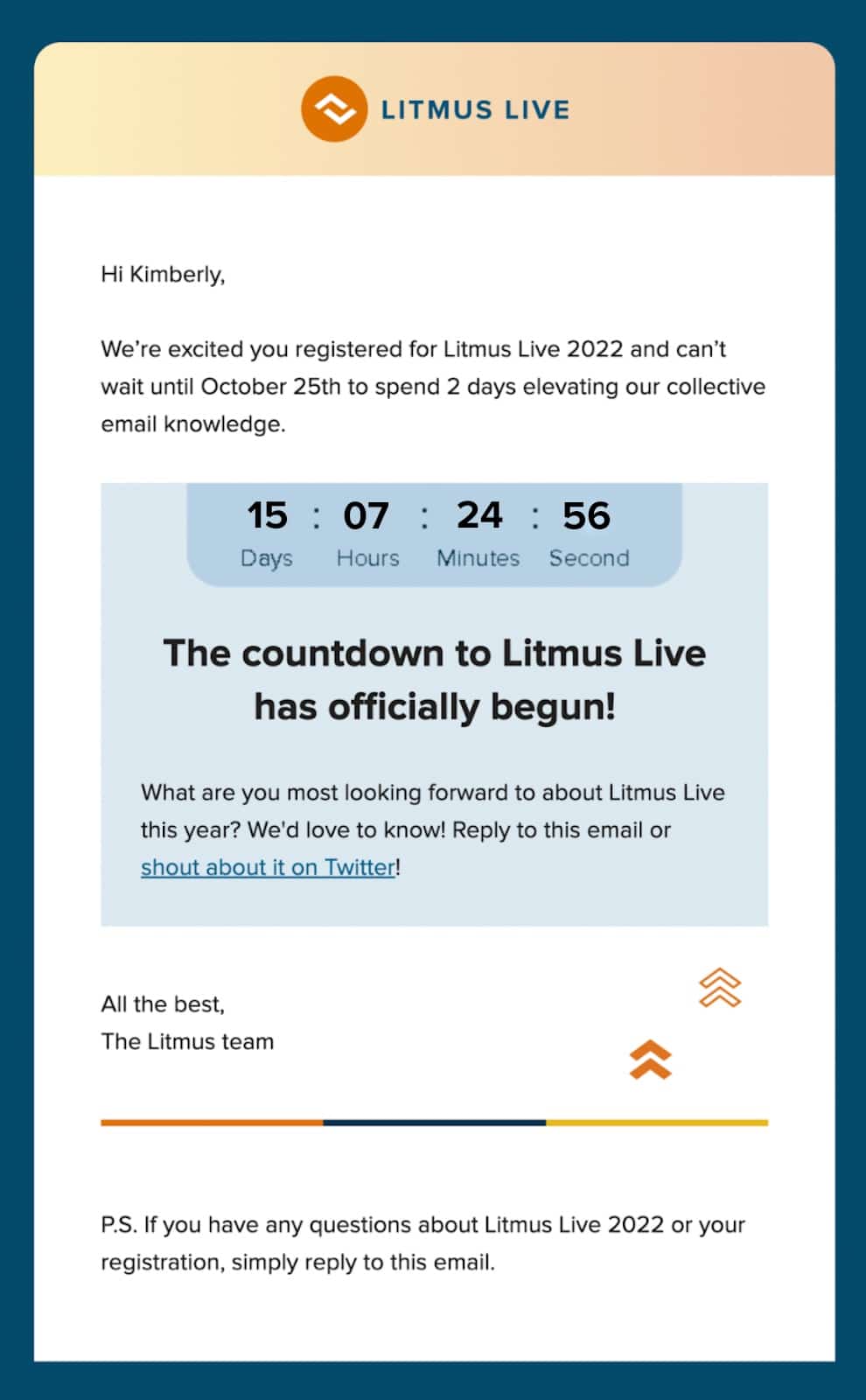
How long is too long for a countdown timer?
Countdown timers don’t create a sense of urgency and scarcity on their own. They work together with the rest of your promotion to do so—that’s why you should only run a countdown timer on a campaign that actually ends. We’d also recommend not using timers when the promotion ends too far in the future because short time windows mean openers are more inclined to take action.
Do countdown timers affect your deliverability?
Like anything with deliverability…it depends. (We know! So frustrating!) There’s nothing inherent about a countdown timer that trips a spam filter, for example. But if you overuse countdown timers—or consistently fake out your subscribers and lose trust with them—it could impact your engagement, which can negatively impact your sender reputation if your subscribers decide to start marking your emails as spam
Can you include other kinds of personalization with a timer?
Yes, of course! Litmus Personalize allows you to add multiple layers of real-time personalization in your emails alongside a countdown timer. A great example of pairing a countdown timer with other live content is with personalized images. Creating a dynamic, individualized experience at scale? *chef’s kiss*
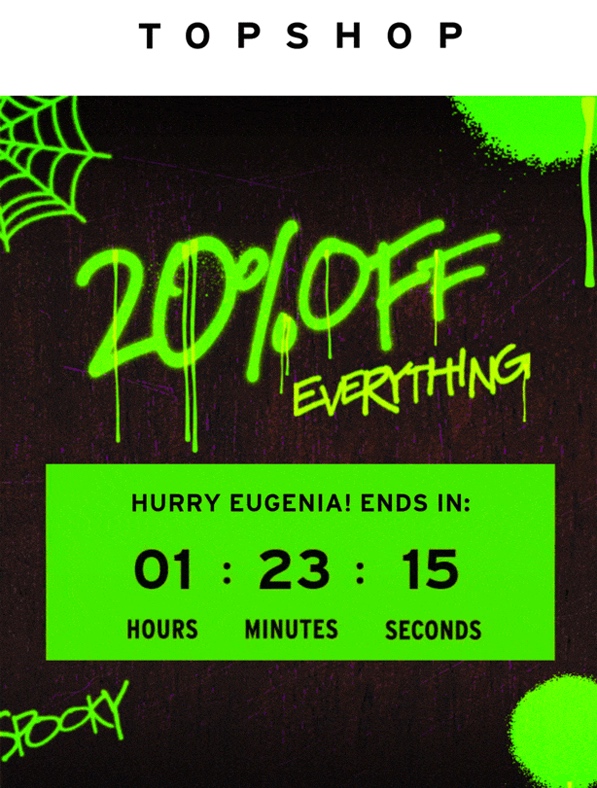
This timer from fashion retailer Topshop includes the recipient’s name (via personalized imagery) above the countdown timer, adding a touch of personalization as well as urgency to shop.
It still blows our minds that 56% of marketers personalize less than 25% of emails they send. Countdown timers are just one way to personalize your emails—the more you can use subscriber data and behavior to build a dynamic, individualized email, the better performance you’ll see.
Part of why marketers don’t use personalization as much as they could is because it has a reputation for being finicky and difficult to implement with email client support and coding hoops you have to jump through. With Litmus Personalize, you can easily add all kinds of dynamic content without needing to be a coding whiz. The more creative, the better.
A note on the ethics of using a countdown timer
Urgency and scarcity are both effective psychological tools to encourage more people to sign up or purchase from you. But you should use them sparingly, and ethically.
Don’t mislead your subscribers by making them think a sale is ending when you’ll be running another one in 24 hours or telling them there are only a few items left in stock when you have warehouses full of inventory. Countdown timers can create a sense of urgency around an event or promotion, but only if the event or promotion actually has an end date.
“If you say something is going to end, then it has to end,” says Slater. “Otherwise, it’s a breach of trust. It’s like the boy who cried wolf, essentially. People aren’t going to trust you after that. Especially if you do it repeatedly.”
If you create a false sense of urgency with a countdown timer your subscribers will remember and adding a countdown timer to your next email might not have the impact that you would like.
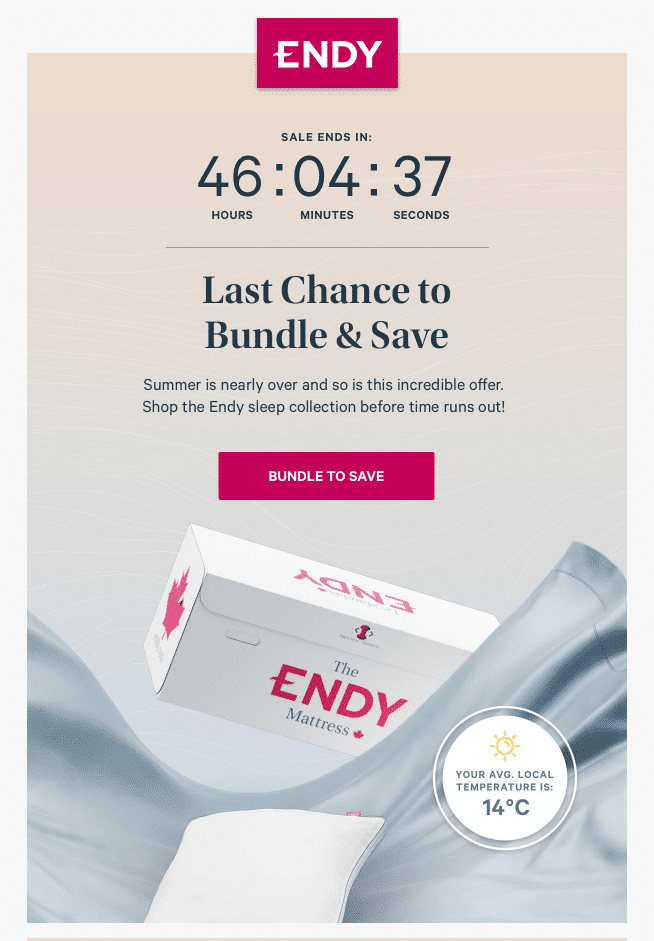
How to message and label your countdown timers
For maximum impact, clear messaging is essential to making a countdown timer meaningful and easy to understand. In some cases, we’ve seen countdown timers placed at the top of an email without any other information. “If it’s just a banner across the top with no explanation or reason as to why it’s there, it won’t perform as well. Why are we counting down? Why should I be excited about this?” says Slater.
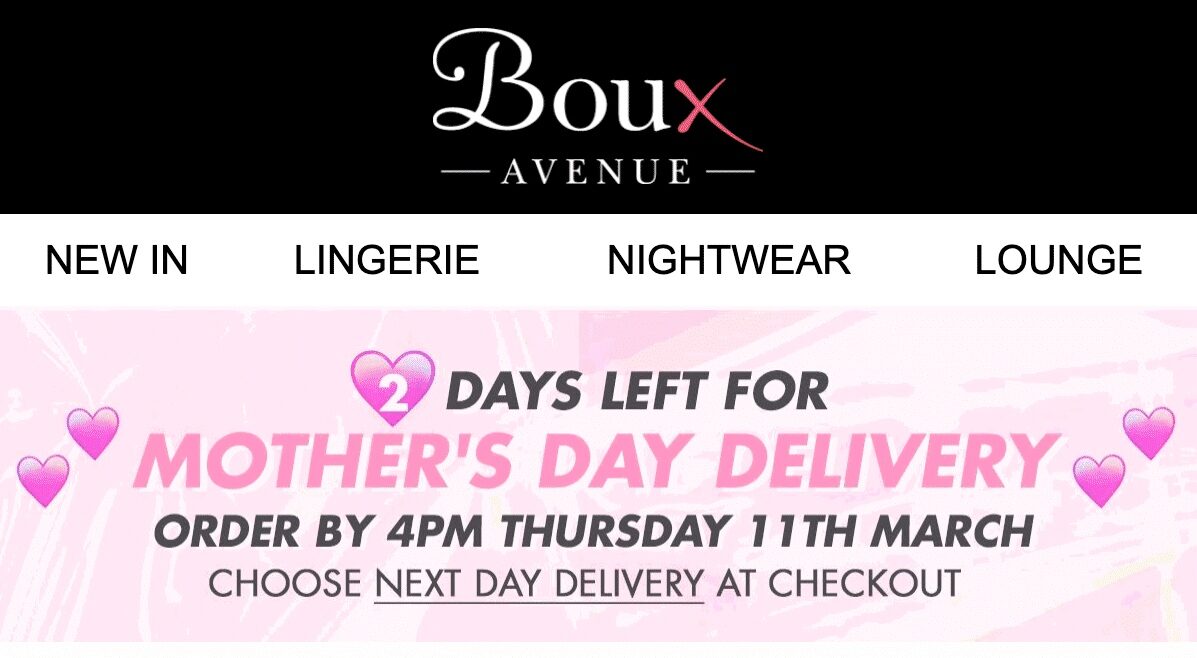
This example from lingerie retailer Boux Avenue uses clear, informative messaging, but still keeps the brand’s identity at the forefront.
Then, make sure to put time labels on every countdown timer so recipients know how long they have left before the timer runs out. Don’t forget to include days, hours, minutes, or seconds to make it clear to subscribers what you’re counting down to. Avoid only using numbers as this can be confusing.
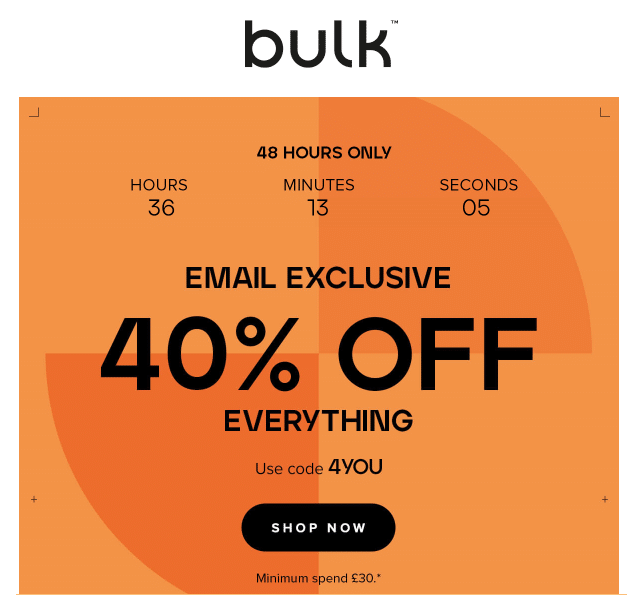
In this example from sports nutrition and wellness retailer Bulk, they’ve clearly marked out the hours, minutes, and seconds in the header image. This seems like a simple step, but it’s one too many brands forget.
Increase conversions with Litmus Personalize
It doesn’t take fancy coding to add a countdown timer or other powerful personalization tactics to your next email campaign. Use Litmus Personalize to create gorgeous email designs tailored to individual subscribers. Learn more >